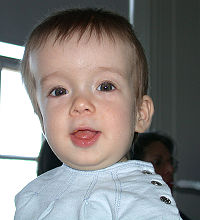
Photo from wikipedia
Background: Growing skull fracture (GSF) is a rare, posttraumatic complication observed mainly in young infants. In GSF, the skull fracture associated with an underlying dural tear gradually expands due to… Click to show full abstract
Background: Growing skull fracture (GSF) is a rare, posttraumatic complication observed mainly in young infants. In GSF, the skull fracture associated with an underlying dural tear gradually expands due to herniation of the intracranial tissue into the fracture site. Many reports have discussed GSF from various points of view. However, only a few studies have focused on the details of cranial reconstruction. The present study aims to redress this omission by shedding some light on bone work in GSF surgery. Methods: Patients registered in the institutional database who underwent surgical repair of GSF were retrospectively reviewed. Results: Four patients underwent surgical repair for GSF. The site of injury was parietal in 3 patients and occipital in 1 patient . Age at the time of injury ranged from 3 months to 1 year 5 months (mean: 7 months). The duration from injury to surgery ranged from 5 to 7 months (mean: 5 months). In all patients, dural reconstruction was performed with autologous periosteum and cranial reconstruction was performed with an autologous calvarial bone graft. Regardless of the age distribution, split bone grafting was possible for all patients. Conclusion: To diagnose GSF promptly and thereby reduce the risk of neurologic sequelae, careful observation of the course, and education of the patients’ parents are desirable. Although most children with GSF are under 3 years old, the age before the formation of the diploic layer, split bone grafts should be considered for the treatment of GSF to reduce the risk of residual cranial bone defects.
Journal Title: Journal of Craniofacial Surgery
Year Published: 2019
Link to full text (if available)
Share on Social Media: Sign Up to like & get
recommendations!